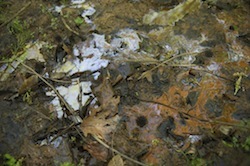SEJournal Online is the digital news magazine of the Society of Environmental Journalists. Learn more about SEJournal Online, including submission, subscription and advertising information.
December 13, 2016
TipSheet: Coal-Ash Issue Not So Easy To Dispose Of
Hidden in the water bill Congress sent early morning Dec. 10 to President Obama is a provision taking authority over coal-ash pollution standards away from the feds and giving it to the states and utilities.
 The electric utilities couldn’t be happier. Even if many of them are sidling away from coal as a fuel, many have a huge coal-ash legacy. Over the past century, huge pits and ponds full of potentially toxic coal ash have sat on the U.S. landscape as an unsolved problem.
The electric utilities couldn’t be happier. Even if many of them are sidling away from coal as a fuel, many have a huge coal-ash legacy. Over the past century, huge pits and ponds full of potentially toxic coal ash have sat on the U.S. landscape as an unsolved problem.
Now that your state is responsible for solving it, you may want to write about it. It might surprise you to learn how close the nearest one is.
In December 2008, just weeks before President Barack Obama took office, a dam failed at the TVA’s Kingston Fossil Plant coal-ash pond in Tennessee. Over a billion gallons of coal-ash slurry buried local dwellings and polluted local streams. At a Senate hearing the following month, Obama’s incoming U.S. Environmental Protection Agency administrator, Lisa P. Jackson, vowed to do something about it. Coal-burning utilities and environmentalists lobbied heavily.
Unable to decide, EPA in 2010 proposed two options: one regulating coal ash stringently as hazardous waste (favored by environmentalists) and the other treating it as ordinary waste (favored by utilities). It was not until 2015 that the final rule took effect, regulating coal as ordinary solid waste, but with extra safeguards. Almost immediately, Republicans in Congress began trying to repeal the rule.
While early headlines focused on catastrophic dam failures, the real problem is pollution of the streams, lakes and groundwater people use for drinking. Coal ash contains toxic heavy metals like lead, mercury, arsenic, hexavalent chromium and cadmium that can leach into groundwater. The coal ash is typically stored in unlined, unstable pits near the power plant — and often near a body of water. Truly safe and permanent disposal is still rare, although strides have been made in recent years.
 |
| Toxic water found by a North Carolina environmental group less than 500 feet from a Duke Energy coal-ash pond in 2014. Photo: Dot Griffith, Waterkeeper Alliance (Flickr Creative Commons) |
So the starting point in covering any ash pit is to contact the state agency that oversees solid and hazardous waste under the Resource Conservation and Recovery Act, or RCRA. Here is a list of state agencies. Be sure to ask about pollution monitoring.
There are roughly 1,400 coal-ash sites nationwide. To find a coal-ash pit near you, you may only have to look. But online and data tools can help you find it.
One, run by the Environmental Integrity Project, is called Ashtracker. You can search it by state, owner or facility name. Ashtracker’s strength is a focus on groundwater pollution monitoring data.
SourceWatch, a project of the Center for Media and Democracy, has a database whose strength is the aerial photos of the actual utility sites (taken from Google Maps) that allow you to understand site layout. They also often show how frighteningly close the ash pits are to important streams, with potential flood threats.
EPA has a useful list of coal-ash sites that can help reporters. A “compliance list” from after the regulation was issued has links to coal-ash sites where required information is posted. The compliance list is not exactly a database. Another list, based on an older study, is here. The spreadsheet from EPA’s original survey is here.
Earthjustice, which partners with the Environmental Integrity Project, has its own map-based database of coal-ash sites here, with focus on hazardous dams at coal-ash impoundments.
On the environmental side, the two best groups on coal ash are the Environmental Integrity Project (Tom Pelton, 443-510-2574, tpelton@environmentalintegrity.org) and Earthjustice (Lisa Evans via Phillip Ellis, 202-745-5221, media@earthjustice.org).
On the industry side, check in with the American Coal Ash Association (John Ward, 801-560-9801) and the Utility Solid Waste Activities Group (James R. Roewer, 202-508-5645, jim.roewer@uswag.org).
EPA’s current press officer for coal ash is Christie St. Clair (202-564-2880 or 202-768-5780, stclair.christie@epa.gov).
* From the weekly news magazine SEJournal Online, Vol. 1, No. 7. Content from each new issue of SEJournal Online is available to the public via the SEJournal Online main page. Subscribe to the e-newsletter here. And see past issues of the SEJournal archived here.
SEJ Publication Types:
Topics on the Beat:
Region:
Visibility:












 Advertisement
Advertisement 



